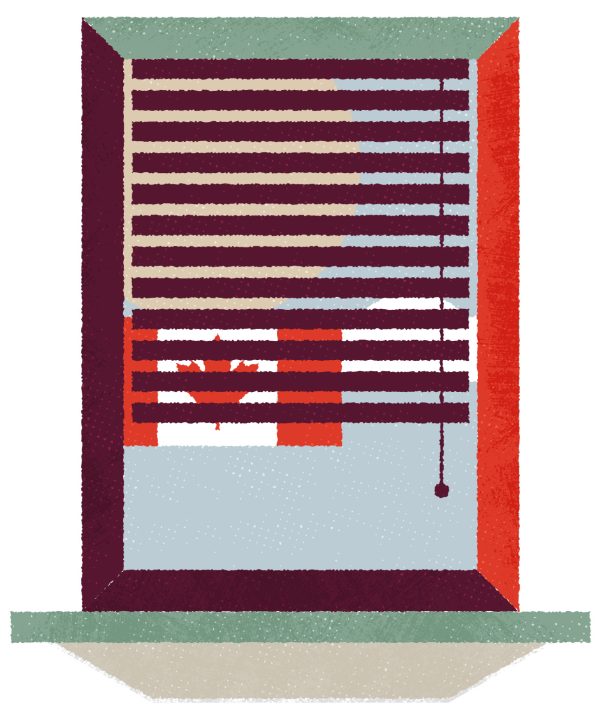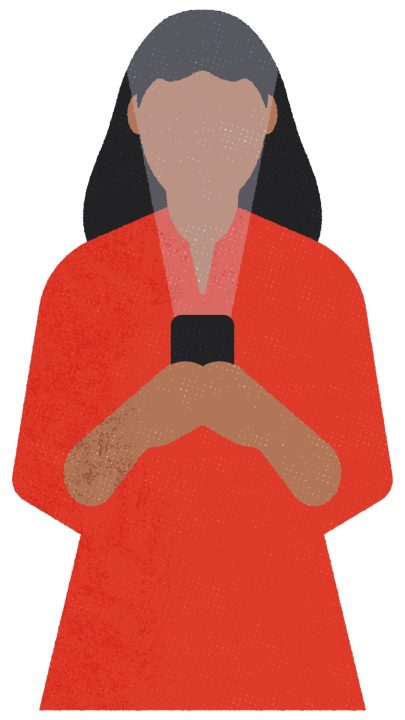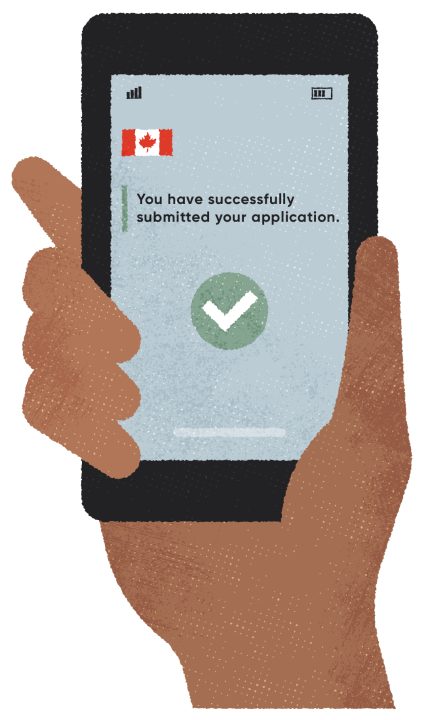
Priya looked up from her phone and took a breath. She was speechless and more anxious than she had been in a long time. Did she just read that in three weeks the Canadian government would announce a new pathway to permanent residency?
This had to be the answer to her months and months of prayer. Her three years of working and applying for permanent residency was almost up, and she had still not met the requirements to qualify. Her belongings had already been packed, donated, or tossed as she had been preparing to return to her home country. The COVID-19 pandemic had triggered the closure of borders all over the world, which was the only thing that had delayed her purchasing her return ticket to Bangladesh.
Priya and her family had planned for a long time before she made the move to Canada. Seeking a better life, they had sacrificed a lot and invested all their savings, hoping it would pay off someday. The plan had been simple: she would leave her husband and children to pursue higher education in Canada.
During this time her husband would keep his successful medical practice and continue to support their family. After she received her permanent residency, her husband and children would join her in Canada; this would guarantee that they had sufficient resources to meet all their obligations. The costs of international tuition fees were sometimes daunting, and the only way to keep afloat was for one spouse to bear the financial responsibility.
A pandemic creates an opportunity
It had been a frustrating and difficult year for her and so many others, and day by day her journey to attaining her permanent residency had seemed like a wish floating away in the wind. Her thoughts were interrupted by the ringing phone. She sighed audibly and looked down at the phone on the table, seeing her friend’s picture on her caller ID.
“Did you see what I just sent you?” Maria shrieked when Priya answered.
“Yes, I was just looking at it,” Priya responded, distracted.
“Isn’t that unbelievable? We qualify! We definitely qualify!” screamed Maria.
Maria was originally from Brazil. The two had met in class, and they connected well.
Their situations were very different and yet had similarities. Maria had no husband or children, but she did have two younger brothers and a sister. Maria’s entire family had saved up and chipped in to cover her trip to Canada. It was her responsibility, however, to work and support herself and cover as much of her tuition as she could. It had not been easy, especially since during school she could only work twenty hours per week, but she had completed her program successfully and was working two jobs before the pandemic hit. Once she attained her permanent residency she would be able to help her brothers and sister move to Canada.
It had been almost five years since they had both arrived in Canada. They each had two months remaining on their work permits, and their options were to return home or face deportation—at least those were the options before this fantastic opportunity that was now staring them in the face.
“What did it say we need to apply?” Priya quizzed
“We already qualify, Priya! We would apply under the International Student stream. The requirement is that the applicant must have graduated from a designated learning institution after 2017 and currently be employed. We graduated last year and we are employed! That’s all that we need— our job positions don’t matter!” Maria responded excitedly.
Too good to be true?
Using her phone, Priya went online and looked again at the requirements.
“OH MY GOD! We really do qualify!” she breathed in a low whisper of disbelief.
“That’s what I told you. I read it about three times before I sent it to you!”
“Okay, let’s do it—where do we apply?” Priya asked impatiently.
“We can’t yet—it doesn’t open until May 6, 2021.”
“Oh goodness, I’m going to explode with excitement!”
“I know what you mean—we all are,” Maria giggled.

The first of its kind
This new pathway was the first of its kind, according to the news reports, documents, and immigration articles that Priya read. The Canadian government had decided to introduce this new conduit to permanent residency in consideration of the international students and healthcare workers that had been stuck in Canada throughout the pandemic. Never before had a person’s job title not mattered, nor had Canadian Language Benchmark scores below seven (the normal minimum language requirement on a scale that stops at 10) been deemed as acceptable. This was unheard of and almost felt too good to be true. This was the window of hope she and others in her position had been praying for, but Priya was almost afraid to get too excited.
On her way to work that morning, Priya did what she always did on her daily bus commute: scroll through her phone to look at the latest news from Bangladesh. As she read the headlines, she glanced through the bus window, thinking about the years before her move to Canada. Their life had been good back home. Priya had been a systems engineer at a software development company, and her husband was a medical doctor. They lived well and could afford the best of life in Bangladesh. They lived in a fantastic neighbourhood, their children went to the best schools, and they were exposed to the best Bangladesh had to offer. Still, they dreamed of more for their children, with more opportunities, a safer society, and a better future—a future where they could pursue any career they wanted to, and in a first-world country.
The path to permanent residency had been so different from what Priya and her family had anticipated. Not one day passed without her wondering if they had made the right decision as a family. Her children were now twelve and nine years old, and she often felt like she was missing out on them growing up.
The immigration consultant they had worked with, and the research they had done online, had made it seem so easy. Priya would finish her studies, earn her post-graduate work permit (PGWP), get a job, work for a year, apply for permanent residency status for herself and her family, then have her family join her in Canada. However, the actual journey had been so very different. Priya had started looking for jobs the second day after landing in Victoria. Working as a successful, highly qualified systems engineer with over eighteen years of experience in the field, she had assumed that landing a job in her field would be a breeze. Nothing was further from the truth. Priya had sent out hundreds of resumés, attended numerous job fairs, sought out many networking events, but all to no avail. She needed a job in a supervisory position for at least a year to meet the permanent residency application requirement. However, after two months of searching, and desperate to earn an income, she took a job at a fast-food restaurant. It was certainly not what she had expected she would be doing, but it could contribute to the bills.
May 6, 2021
The weeks leading up to the May 6th opening of the new pathway were filled with many emotions. There was joy, excitement, apprehension, and fear within the newcomer community. The dominant emotion, however, was fear—fear of unpreparedness, fear of technical glitches, and most of all fear that they didn’t make it into the group that was limited to 40,000 candidates Canadawide. This was a once-in-a-lifetime opportunity, and everyone wanted in.
Speculation abounded as the eligibility requirements were published, but exactly what would be required to submit the application would not be known until the policy took effect. The applicants fell into a frenzy of activity doing all one could to get prepared, and COVID-19 restrictions did not make it any easier. Appointments for permanent residency medicals on Vancouver Island became a scarcity, as did the appointments for the English tests.
Priya and Maria were able to get appointments for their medical and English tests in the second week in June 2021, a full month after the opening date. Getting the police records was a completely different story, but they started the process and hoped that was enough.
As the time grew closer to application opening day, their anxiety grew and grew. The day before the applications were to open, Priya felt unprepared and nervous beyond words. There were so many questions, and uncertainty fueled more and more. Would they have enough time to meet all requirements? How long would it take for the 40,000 applicants to be chosen? Getting all the documents prepared was also costly and may well have been a barrier for many people.
On the morning of May 6, 2021, a huge number of qualified newcomers hoping for permanent residency tried to get their application in online. It was chaos—the site moved slow for some, payments wouldn’t go through for others, and some didn’t have all the documents, so the process couldn’t move forward for them. It was a day of great anxiety.
That afternoon, at 4:48 pm, after trying to complete the process for most of the day, Priya looked at the screen and read: “Your application has been submitted.”
Tears filled her eyes; it felt like a miracle to have the application go through. She had all but given up hope that the pieces would fall into place, and yet they had, right in the nick of time. The weeks leading up to this moment had been gruelling, but now it felt like all the effort and anxiety were worth it. She smiled to herself, knowing she would have her family with her in a few months. All their plans could finally start taking shape. Her husband and her children would be with her once again, and her family would be complete. Finally the pieces seemed to fit. Finally it was all coming together as she took another step forward in her journey as an immigrant.

Priya texted her husband: “Submitted, we did it!” Then she called Maria, who picked up on the third ring.
“Has your application gone through?” Priya asked.
“No, not yet. I’m still trying.”
“What’s wrong?”
“The payment screen has an issue, it seems.”
“Yes, I know; I got that too, but I waited about seven minutes and tried again. Let me know when you have submitted, okay?”
“Will do,” Maria responded, sounding defeated.
Finding the extra funds to pay for medical tests, police records, the English test scores, plus the application fee had not been easy on anyone, but for Maria it had been a real challenge.
At 7:48 pm, Priya got the text from her friend: “Submitted, finally. I’m exhausted. Going to bed.”
Priya responded, “We did it! Now we wait.”
Placing her phone on the night table beside her bed, Priya exhaled and settled into the pillows behind her.
As of press time mid-December 2021, the applicants whose experiences are embedded in this story have not yet heard about the status of their permanent residency applications.
This piece was originally published in print in January 2022. Read all the #WeAreHere featured articles here